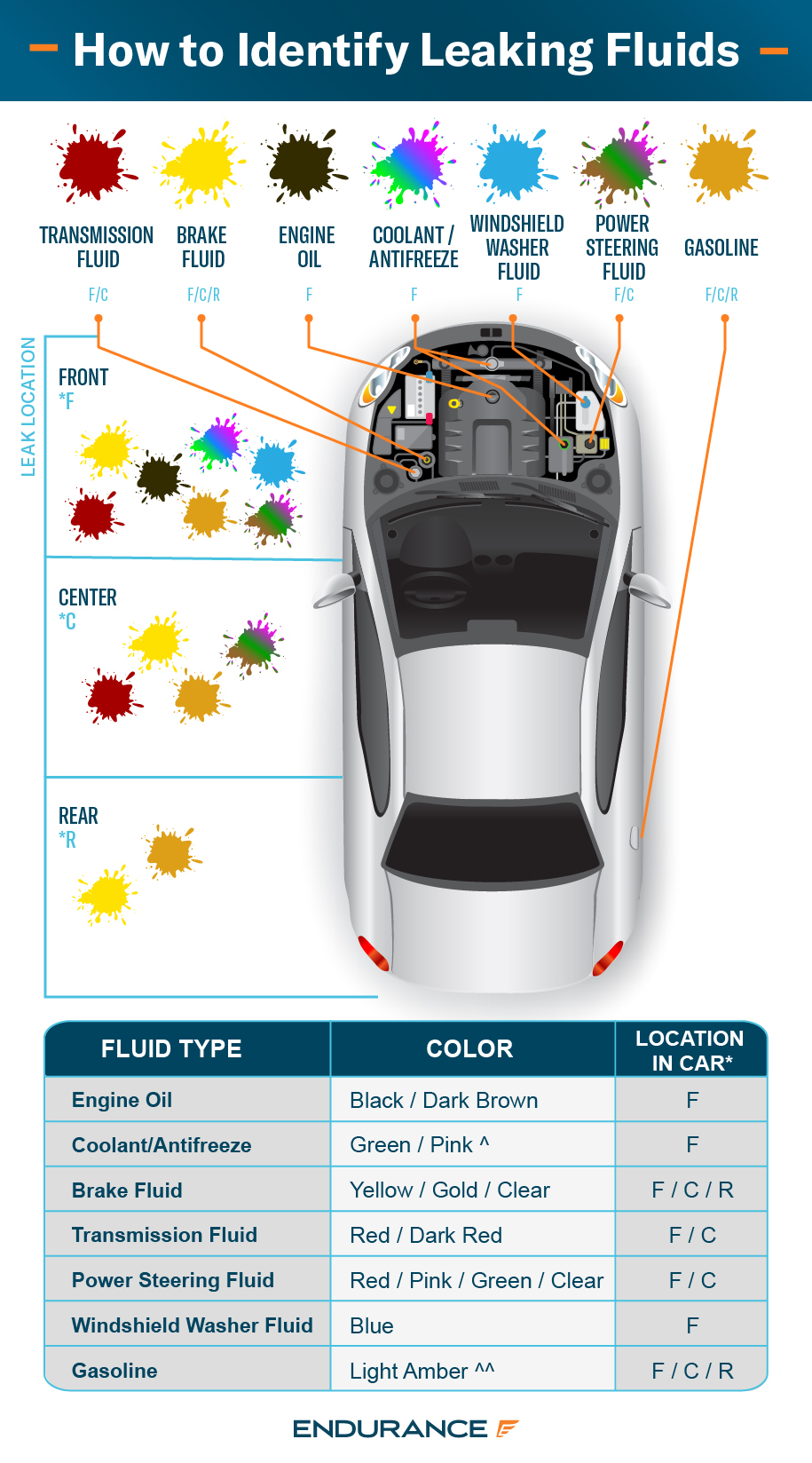Qué hacer si su automóvil pierde líquidos

Let’s face it, between apple picking, football tailgating, or enjoying your favorite pumpkin-spiced treats, the fall can give anyone something to look forward to. But, regardless of the reason for getting out of the house and hitting the road, the last thing you’d want to discover is a mysterious puddle under the car.
That’s why familiarizing yourself with your car’s líquidos esenciales and the steps you should take when dealing with leaking fluids before heading out for your next fall adventure or any other trip at any time of the year is vital as a car owner.
What Are a Car’s Top Essential Fluids?
Many think of a car as a complex machine with partes móviles and numerous systems (like the engine and transmission), and they’re absolutely right. However, many don’t know that a car’s líquidos esenciales keep things running, nor what kind of fluids a car needs, apart from gasoline and oil.
And while your car’s el manual del propietario can help you learn more about what líquidos esenciales your car needs, knowing some basics can help you be better prepared as a car owner.
Aceite de motor
Lubricación for an engine is about as basic as it gets with fluidos vehiculares; it’s an essential liquid that keeps the internal components moving smoothly. Motor oil (también conocido como aceite de motor) is usually dark brown (old or dirty oil can appear black) and has the consistency of pancake syrup. Leaking aceite de motor will accumulate under the engine, and checking the oil con el varilla graduada may also reveal a below-normal nivel de líquido.
Refrigerante
Sometimes called anticongelante, refrigerante is used by a car’s radiador and travels to and from the engine to maintain a proper temperature and prevent calentamiento excesivo. Basically, it keeps your motor frío enough not to destroy itself while driving.
You’ll find that most engine coolants, which are somewhat thicker than water, come in a bright green or pink color, but some solutions are blue, orange, yellow, or purple. Refrigerante puddles can accumulate at the front of the car or underneath the engine, like oil, but with a different look and consistency. Some vehicles may have a nivel de refrigerante indicator, too. However, never open the tapa del radiador of a hot refrigerante system, as you can risk burning yourself.
Líquido de frenos
Mayoría modern cars’ braking sistema is a hydraulic system, and the key component to this type of setup is fluid (which helps maintain proper pressure and functionality). Líquido de frenos runs from the brake cilindro maestro a través de líneas de freno to each wheel, so a leak can occur just about anywhere under a car. In particular, look for líquido de frenos drippings near the wheels and underneath the engine bay. Líquido de frenos is dark yellow or gold and has a thickness like cooking oil.
Líquido de transmisión
Like an engine, a transmisión has numerous internal components that require constant lubricación. You’ll want to pay attention to a red-colored fluid that pools underneath the front or center of the car. Transmisión líquido has an oily consistency but isn’t as thick as aceite de motor.
Líquido de dirección asistida
Dirección asistida is another hydraulic system that requires fluid for safe operation. Look for a red, pink, or light brown liquid if you’re concerned about leaking líquido de dirección asistida (which has a thickness similar to fluido de transmisión). Any liquid from the power steering system will be located underneath the engine area.
Líquido lavaparabrisas
While not a critical liquid for a car’s mechanical systems, líquido lavaparabrisas is still essential for ensuring good outward visibility for those behind the wheel. This fluid has a blue tint and flows like water. Leaks are usually noticeable underneath the fluid reservoir, but problems can also occur below the feeder line and the limpiaparabrisas.
Gasolina
While no gas means no go, there’s something more important to consider with leaking gasolina; a significant fire hazard. So, you’ll want to be alert for a light amber color liquid with a consistency similar to water. In addition, you may notice a rainbow-like sheen if there’s enough accumulation. Gasolina leaks can be found underneath the engine and fuel tank (usually in the rear) or below the lines connecting these two components. A sudden drop in economía de combustible can also indicate a problem, so if you find yourself driving to el gasolinera more often than usual for a fill-up, look to get your car checked by a mecanico profesional.
Qué hacer si su automóvil pierde líquidos
Determining the source and significance of a car fluid leak is a straightforward process, though it requires some clever detective work to determine which exact fluid is leaking.
Here’s how to begin:
Identify the Leak
Sourcing the leak begins with determining where the fluid accumulation is under the car. This helps rule out specific problem areas. For example, a leak at the back of the vehicle isn’t likely to be refrigerante o aceite de motor (unless you’ve parked on an incline and there’s a trail from the front of the car).
Avoid touching any leaked fluid as these substances can irritate the skin, and NEVER taste a car fluid, as they’re toxic. Instead, use a cotton swab to gather a fluid sample to check the color. In addition, put on a latex or rubber glove before rubbing your fingers together to determine a fluid’s thickness.
A smell can also be a clue about a fluid’s origin. For instance, refrigerante may have a sweet smell because it’s made with glicol etileno. Similarmente, fluido de transmisión may also have a sweet aroma, so further identification by color becomes important. Líquido de frenos can smell like fish oil, while líquido de dirección asistida can have a burnt marshmallow scent. And, of course, gasoline smells like “gasoline.”
Use Cardboard
One hack to help identify a leak is to place a piece of cardboard under the suspect area. Ideally, you can find white-colored material (which makes color identification easier), but taping white paper to cardboard works, too. For instance, grab a piece of paper from a notepad and tape it to the box from your latest Amazon delivery. Ideally, use this handy method when there’s time (like overnight) for the fluid to drip and accumulate on the cardboard.
Determine the Severity of the Leak
Different leaks require different levels of attention. In other words, some leaks are more severe than others. To illustrate, a few drops of aceite de motor should be addressed urgently, but a substantial oil pool means the car shouldn’t be started or driven.
The same goes for most other fluidos vehiculares, especially gasoline. Any gas leak should be addressed immediately due to the flammability of this fluid. On the other hand, it’s pretty safe to say that a líquido limpiaparabrisas leak may not need urgent attention, but the problem shouldn’t be ignored.
Seek Professional Help
A fluid leak is a sign that something is wrong with your car. As such, the issue should be looked at by a mechanic. Most minor leaks may involve a drive to the repair shop, but more severe troubles could require a tow truck to prevent the potential for damage or injury.
Luckily, if you’re an Garantía Endurance customer, you can rest easy as you’ll be able to take your car to any certified repair shop or mechanic, including your car’s dealership. And as a bonus, you’ll also enjoy 24/7 roadside assistance and towing to help take your car to the shop if it can’t be driven. You’ll even have trip interruption coverage AND reembolsos de alquiler de coches, so if your car is leaking fluids when you’re on the road during your next road trip, Endurance will still have you covered.
Vehicle Fluid Cheat Sheet
While learning more about how your car’s líquidos esenciales is vital, having a handy “cheat sheet,” which you can download by clicking the image below, to help identify the most common fluids that may leak from a car can only help you as a car owner.
However, while helpful, always remember that this is based on a conventional vehicle layout, with the engine in the front. In addition, some well-worn fluids may turn dark brown or black over the years.
* F=Front, C=Center, R=Rear
^ Green and pink are the most common refrigerante colors, but blue, orange, yellow, and purple may be used.
^^ Gasoline may come in different shades depending on octane rating, with Regular being greenish or bluish, Midgrade being yellowish and Premium often having a pink hue.
Keep Your Car Road-Ready with Endurance
Being familiar with vehicle fluid leaks and ensuring your líquidos del coche are at the proper levels is just one part of being a propietario del vehículo. Another way is to be prepared for breakdowns and unexpected repair bills with a Plan de protección del vehículo de Endurance. There are options to safeguard the powertrain or coverage similar to a new car warranty. Endurance even offers programs for select luxury models and commercial-use vehicles.
All Endurance customers can enjoy 24/7 roadside assistance, trip-interruption protection, and rental car support. In addition, there’s a 30-day money-back guarantee, convenient payment plans, and the ability to choose any Mecánico certificado ASE for repair work. Plus, new plan holders can activate one year of Beneficios de élite with extras such as tire repairs and replacements, total loss coverage, and key fob replacements.
Learn more about an Endurance auto protection plan by Solicitar presupuesto gratuito y sin compromiso. Or, call (800) 253-8203 to speak with a customer care representative to learn more about how Endurance’s award-winning coverage can help you. Also, check out the Blog Endurance for even more helpful articles on DIY maintenance tips, expert advice, vehicle comparisons, and more.














Larry Witherspoon Jr. es cofundador y director ejecutivo de Centro de formación automotriz. Larry ha ocupado múltiples puestos de liderazgo en la Marina de los EE. UU. y en varias empresas Fortune 100. Además de su experiencia empresarial, Larry creció entendiendo las dificultades que todos los jóvenes enfrentan al convertirse en adultos, especialmente aquellos que surgen de circunstancias difíciles. Tomó esas experiencias de niño y las combinó con su pasión por los vehículos para iniciar el Centro de capacitación automotriz. Leer más sobre Larry.